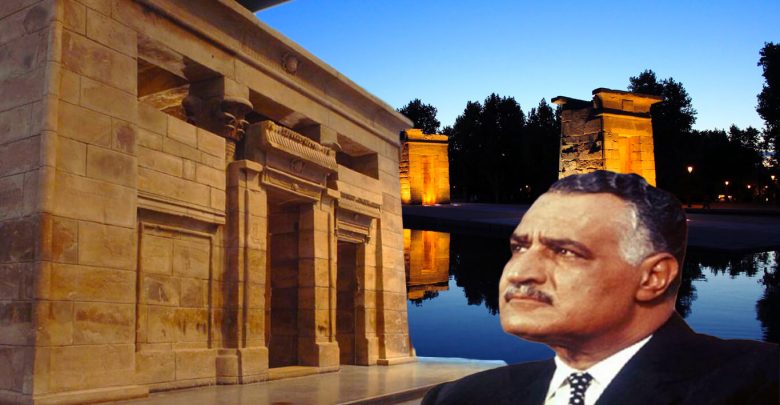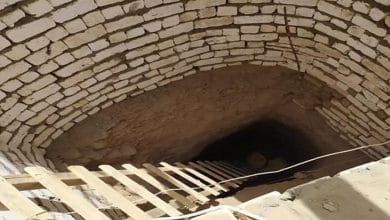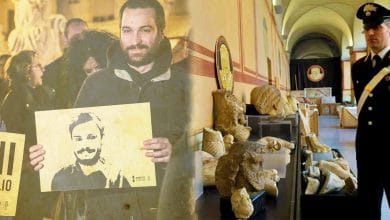
Hidden aspects in stealing Egypt’s monuments
Hidden aspects in stealing Egypt’s monuments
Introduction
An important issue has preoccupied Egyptian public opinion recently: namely the smuggling of ancient Egyptian monuments outside the country. In fact, when the Louvre Abu Dhabi Museum displayed Egyptian artifacts during its opening in November, 2017, people were skeptical about the matter. This prompted me to seek out the dimensions of the issue, its origins and its implications.
The roots
The issue of stealing Egyptian antifacts is not a new phenomenon, but it is as old as the Egyptian monuments. In fact, this issue traces back to the days of the Pharaohs themselves; and has continued over the following centuries until the present time!!
It is surprising that there is a Pharaonic papyrus that dates back to the reign of Ramses IX (reigned 1129-1111 BC) which indicates the early looting of Egyptian antiquities in the country’s capital at that time, Thebes, at the hands of state officials!!
The papyrus tells us that Basar, the governor of the eastern province of Thebes, was once reported that the tomb of King Sekhem-Re Shedtawy in West Thebes had been stolen. However, Basar used illegal means to extract confessions from the suspects and brought the case to the local minister, Khaam Wast, who re-investigated the defendants. After the defendants denied their previous confessions, the minister, who was probably involved in the incident, dropped all charges and acquitted the thieves. However, upon Basar’s request, the defendants were re-interrogated by a new minister, and finally, the forty-five suspects admitted their crime after they were severely beaten.
It is interesting to note that this papyrus, which indicated that the stealing of antiquities was facilitated by state officials, was also stolen and sold by the end of the nineteenth century AD!! Even when Carter discovered the tomb of Tutankhamun in 1922, he observed that the cemetery had been robbed, although it had not been opened since the Pharaonic era; and he then accused the workers of the city’s monastery who were commissioned to build the tombs in time of committing the crime. The secret hiding place in the Valley of the Kings is a compelling proof that priests transferred the mummies of the Pharaohs and dug them in it after failing to prevent the theft, and remained there until it was discovered in 1870.
After the Roman occupation of Egypt in 32 BC, the Roman tourists, diplomats, ambassadors and military came to Egypt to seek science, culture and entertainment. Among their objectives was to obtain Pharaonic artifacts. The Roman emperor Hadrian (reigned 117- 138 AD) decorated the gardens of Rome with the antiquities of Pharaonic Egypt. Also, the Romans were so fond of the Pharaonic obelisks and their Hieroglyphic inscriptions, that Emperor Constantine the Great (reigned 306-337 AD) took the obelisk of King Thutmose III, which was in Thebes, and moved it to Alexandria and then to Constantinople, which is currently located next to the Hagia Sophia mosque in Istanbul. Another Pharaonic obelisk was transferred to Rome in the era of the Roman Emperor Maximus (reigned 286- 310 AD), which was re-erected during the reign of Pope Sixtus V in 1587.
With the entry of Christianity to Egypt, and the Copts’ rejection of all old worship rituals, including the inscription of temples, which they considered as evils that lead to sin; most of Egyptian monuments were destroyed and sabotaged. Under the pretext of supporting the Christians of Egypt, Roman Emperor Justinian (reigned 527-565 AD) closed the Temple of Isis in Philae and moved its statues to Constantinople!! Therefore, most of the pharaonic monuments on the ground were destroyed in that era, and its stones were used in construction!!
When the Muslims conquered Egypt after defeating the Romans, Amr ibn al-Aas described Egypt accurately as having: “four thousand baths, four thousand palaces, four hundred theaters, and a thousand and two hundred green grcers.” Despite the fact that the Muslim conquerors did not care so much about the Egyptian antiquities, yet they did not involve in sabotaging or destroying them.
With the French occupation of Egypt at the end of the eighteenth century, the French campaign was increasingly interested in the Egyptian monuments, both on or under the ground, especially with the establishment of the French Scientific Complex, which focused on collecting Egyptian monuments. Despite the failure of the French campaign, which lasted three years, but it succeeded scientifically, and one of the most important proposals of the French Scientific Committee was “the selection and transfer of ancient Egyptian monuments, safely to France!”
Vivienne Denon, a French scientist who discovered, photographed and painted many of the Egyptian monuments and carried many of them to Paris, was welcomed upon his return to France and commissioned to create the Louvre Museum where he dedicated the first Egyptian Antiquities Pavilion. But the French campaign when ready to get out of Egypt had accumulated the collected Egyptian antiquities and stored them in Alexandria in preparation for transferring them to Paris, but the British did not make the French take everything they collected. During negotiations between Britain and France on withdrawal, the British leader “Hutchinson” insisted that the French hand over the Egyptian monuments to them!! Also, Earl Cavan, commander of the British forces in Alexandria transferred one of the pharaonic obelisks to London in celebration of the failure of the French campaign, the obelisk that adorns London’s most important square.
Thus, France was one of the most countries in the world to loot the Egyptian antiquities; and the Egyptian monuments currently in the Louvre exceed one hundred thousand pieces.
During the eighteenth century, the process of plundering the Egyptian antiquities began to increase at the hands of foreign politicians, diplomats and clergy. For example, Father Vanselb, who was an agent of Louis XIV, landed in some ancient tombs in Saqqara and obtained some of the bodies of birds stuffed in pots and sent them directly to Paris.
Among the foreign diplomats, who smuggled Egyptian artifacts, was the British “Li Mir”, who worked in Egypt from 1711 to 1722, one of the most prominent foreign consuls who carried with them when they returned to Europe, many Egyptian antiquities such as small statues and talismans and amulets. Another diplomat, Buocock, bought two statues. Bruce recalls: “One of the statues was recently purchased for the King Serendip group, but in any case it was very small in size.” However, the regular looting of Egypt’s antiquities had not yet started. In 1723, Thomas Sergent, an archaeologist, offered to sell the London Archaeological Society a box with statues of a group of Egyptian gods which had recently come from Egypt.
The oldest inventory of Egyptian antiquities found in the Louis XIV Library dating back to 1864 shows that it contains at least thirty-three pieces of Egyptian antiquities, including statues, a number of gourds and seventeen mummies. The Egyptian collection of the English physician Hansson, one of the founders of the British Museum in 1756, included rare scrolls of papyrus, and the London Museum used to buy the Egyptian antiquities immediately after its establishment.
During the eighties of the eighteenth century AD, Marie Antonite, Queen of France, in 1755 showed an excessive passion in Egypt and its monuments. She accordingly ordered the bringing of a number of Egyptian artifacts to the royal palaces. The French Museum of Grenoble, the birthplace of Champollion, also included ten pieces of Egyptian antiquities.
Moneymaking papyrus and mummy trade
The markets of Cairo were widely known for selling Pharaonic antiquities; tourists were willing to buy these objects either for personal acquisition or for profit and trade in Europe.
The mummy trade was a lucrative trade. It was an ancient fact that the bitumen in the bodies of the mummies cured many diseases, wounds and bruises, so it was the envy of foreigners. The oldest Egyptian mummy found so far is in the British Museum. The German traveler Johan Helfrich visited Egypt in 1565 for the purpose of obtaining mummies and for this purpose he exhumed several graves. The Scottish John Sanderson, who was the agent of a Turkish company in Alexandria in 1558, spent much of his time in the trade of mummies and was able to move Egyptian mummies to England after he resorted to bribery to facilitate the smuggling.
Francis I, king of France, was always keen to carry a small roll of mummies for any emergency. In 1638, the French ambassador to Cairo, Cardinal Richelieu, sent a letter to Paris, saying: “The most beautiful ancient monuments have sanctified themselves over many centuries, so that you can choose what you want to decorate your offices or save in your coffers of precious things!”
The Egyptian museums lack papyrus written in demotic or hieratic script, while the Louvre Museum in France alone has more than fifty papyrus (as Salim Hassan said). Also, the precious “Turin” papyrus – containing a list of the names and periods of the reign of kings who ruled Egypt during the Pharaonic era – is located in the Museum “Torino”, Italy.
Egypt’s monuments in European museums
Not only was the Louvre museum that is rich in Egyptian antiquities, but there are also other French museums which include thousands of Egyptian artifacts, including the Museum of Marseilles, which contains more than two thousand artifacts of Egyptian civilization from prehistoric times until the Coptic era only. The Museum of London contains more than fifty thousand Egyptian pieces. Also, European, American and Russian museums contain tens of thousands of pieces of Egyptian antiquities; and these museums possess masterpieces of Egyptian monuments that are unparalleled in our museums: the stone Rosetta, which is the key to the ancient Egyptian language is still outside Egypt, displayed in one of the halls of the British Museum!!
The Museum of Boston in America has won a statue of King Mnqra and his wife, one of the most important pieces of pharaonic monuments dating back to the era of the old state. It is strange enough that the Egyptian Museum displays a replica of this statue.
As for the Egyptian obelisks outside Egypt, the city of Rome had the largest share that it was called the city of the obelisks. It has alone seven Egyptian obelisks. While there are only two obelisks in Egypt currently, there are four Egyptian obelisks in France, one in London, one in Istanbul, one in Brussels, one in Berlin, and one in New York. The total number of Egyptian obelisks all over the world is 23.
Mohammed Ali Pasha was keen on courting the West
Because he was not Egyptian, Mohammed Ali Pasha wanted to consolidate his position internationally. He started courting foreigners and was keen on satisfying them. He opened Egypt’s doors wide to European traders, diplomats and tourists. In this era, foreign consuls and diplomats used to collect Egyptian antiquities. Bernardino Drovetti, France’s first consul in Egypt after the French campaign, traded in the Egyptian antiquities openly. British Consul Henry Sault was fond of the Egyptian antiquities and competed with French Dorvetti for the looting of Egyptian antiquities. Giovanni Battista Belzoni, an Italian diplomat, was also well known for plundering Egyptian antiquities that he carried out in a short time what his rivals failed to do; and motivated others to steal the Egyptian monuments.
Wallace Badge, a Briton who began his career at the Egyptian Antiquities Department in the London Museum, was one of the greediest antiquity collectors in the 19th century.
However, in 1835 Mohammed Ali Pasha ordered the registration of the Egyptian antiquities and the transfer of valuable antiquities to a palace in Azbekiya later called the “Azbekiya Museum”. However, after the death of Mohammad Ali Pasha in 1849, monuments plundering re-emerged again.
In 1863, Khedive Isma’il approved the establishment of a museum of Egyptian antiquities, but the project was not implemented. In 1897, Khedive Abbas Helmi II laid the foundation stone for the Egyptian Museum. In 1902, the Egyptian Antiquities Museum was completed.
Modern era and deliberate sabotage
At the end of the 19th century and until the 1970s, antiquities trade was permissible like other commodities, and the successive Egyptian governments failed to protect them. They did not provide any legislation to prevent them from being acquired and excavated, so many Egyptians used their stones in building homes or sold them outside Egypt.
Moreover, the Egyptian authorities intentionally or unintentionally gave up Egyptian monuments. For example, President Gamal Abdel Nasser gave up five Egyptian temples after the construction of the High Dam. He issued Decree No. 4647 of 1966 on 17/12/1966, under which he gave the Dandoor Temple to the Government of the United States – a Roman temple from the reign of Emperor August (reigned 27 BC – 14 AD). He also gave the temple of Dabud in Nubia to Spain in 1960, the temple of Tafa to the Netherlands, the temple of Lycee to Italy, and the Ptolemaic gate of the Kalabsha temple to Germany. These temples still attract hundreds of thousands of tourists each year.
To be continued…




